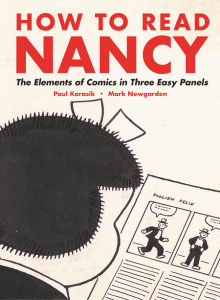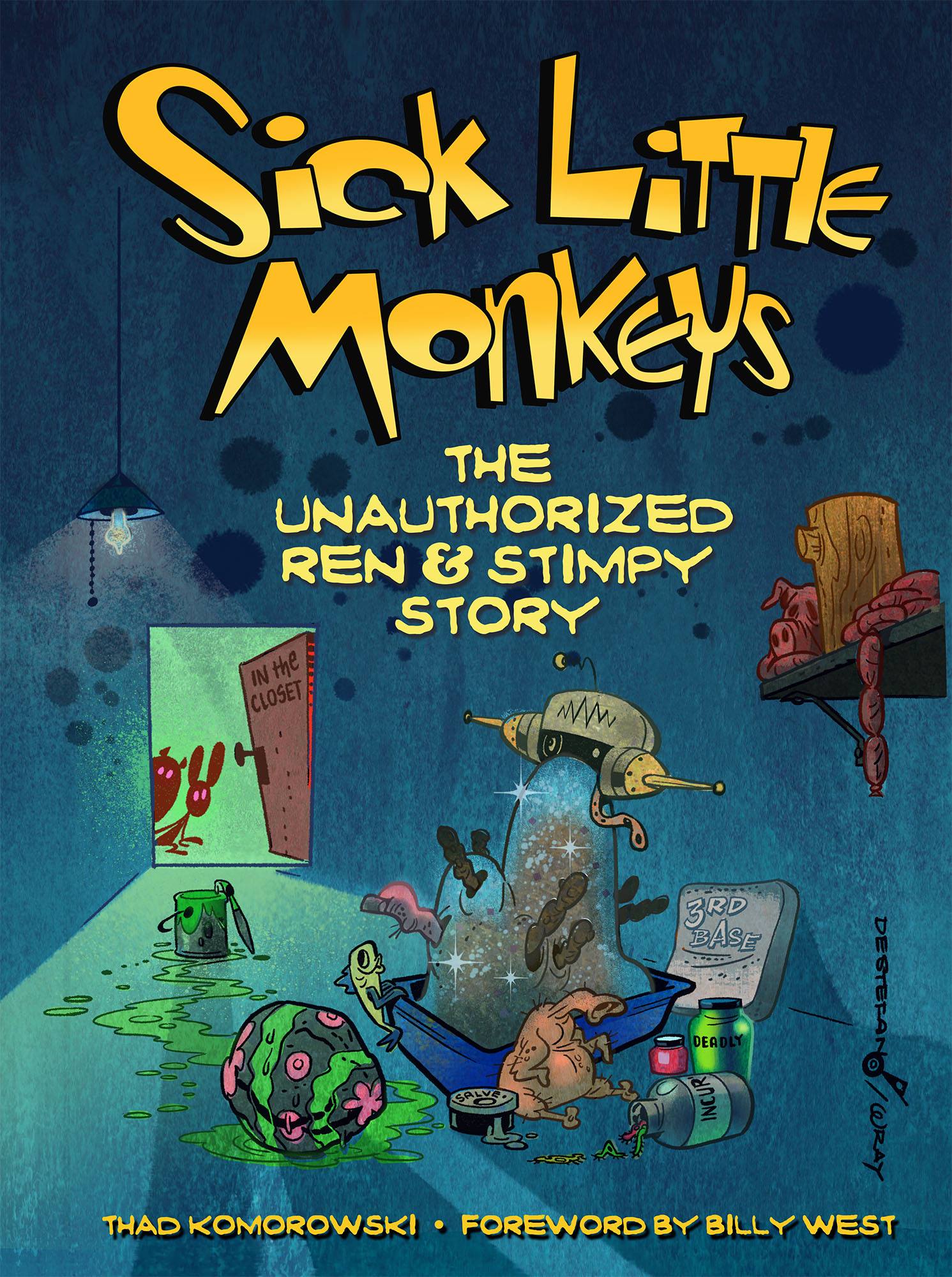Top: the Aug. 1, 1941 strip of Ernie Bushmiller’s Nancy. Bottom: the Terrytoon School Daze, one of two failed animated shorts with Bushmiller’s Nancy and Sluggo. The adaptation of that ’41 strip starts at around 1:25. Note that the strip (which is even legible at thumbnail size) is readable in some six seconds, whereas the Terry guys ballooned the joke to some 90 seconds. The new Fantagraphics book How to Read Nancy: The Elements of Comics in Three Easy Panels doesn’t discuss why things went so wrong with the animated cartoon, unfortunately, but once you finish the book you can probably figure out why.
Full-disclosure: this review is by someone who has chided Mark Newgarden over the years for even doing his long-gestating How to Read Nancy project with Paul Karasik. Along the lines of, “How to Read Nancy? With your Eyes Wide Shut.” But I always knew if someone like Mark respects Ernie Bushmiller enough to do a 44-chapter-and-then-some intense study of him, there has to be something special at work there.
 How to Read Nancy will inevitably be an important college text: its writing is engaging but never fannish, and breaks down the concepts of visual storytelling in a manner that will not turn off the average reader or student. I can easily see this becoming an alternative to Scott McCloud’s Understanding Comics in many curriculums. That book has its virtues and will always be valuable, but I always thought it an awful idea for McCloud to do it as an actual comic book. Newgarden and Karasik lavishly illustrate the history and their thesis, and also understand that concepts need to be explained in words without distracting the reader with the authors’ own creative concept.
How to Read Nancy will inevitably be an important college text: its writing is engaging but never fannish, and breaks down the concepts of visual storytelling in a manner that will not turn off the average reader or student. I can easily see this becoming an alternative to Scott McCloud’s Understanding Comics in many curriculums. That book has its virtues and will always be valuable, but I always thought it an awful idea for McCloud to do it as an actual comic book. Newgarden and Karasik lavishly illustrate the history and their thesis, and also understand that concepts need to be explained in words without distracting the reader with the authors’ own creative concept.
Which is the point of the book and its subject: simplicity is important, underrated, and misunderstood. Newgarden and Karasik don’t try to hide that the prevailing opinion in the comic critics world is that Bushmiller was a hack. As they said in a Comics Journal interview: “Krazy Kat and Little Nemo resemble “Art.” Peanuts resembles “Philosophy.” Nancy resembles nothing more and nothing less than a comic strip (and a gag-driven, self-proclaimed “dumb” one at that), hence: easily dismissed from the canon.”
I certainly sympathize with battling critical prejudice. Friz Freleng gets the same flak from animation fans and historians for not being as flamboyant as the other Hollywood cartoon directors, despite the simple poses and animation in his cartoons generating as many (and arguably more) laughs as anyone else’s pictures. While I didn’t leave the book thinking Nancy is some misunderstood classic that deserves the sort of attention as Herriman, Schulz, or Milt Gross’ work, the authors have certainly made their case that Bushmiller implemented intelligent design on a daily basis. And not just because of his intense gag-writing process that’s covered well here.
The fact is, a lot of comic strips were and are junk. Newgarden and Karasik are able to take a single innocuous Nancy cartoon and analyze some forty-four elements within the following categories: the strip, the script, the cast, props and special effects, costumes, production design, staging, performance, the cartoonist’s eye and hand, details, and the reader. In not one single instance does it feel like they’re reaching—the elements are all there and done well enough that they can be highlighted individually. I’m hard pressed to think of another strip simple enough to analyze cartooning principles in this depth, even my absolute favorites. Maybe a Peanuts strip, but then again, that “philosophy” would overshadow the non-philosophical lesson intended. There’s no “philosophy” at work in Nancy—just craftsmanship that delivers the goods in seconds. That certainly cannot be said for all the long-standing dinosaurs that are part of the King Features family. And that’s why the book is proving so interesting and popular: that you can mine all of this education out of a dismissible Nancy strip.
One other element of the book I particularly admired, as a fellow cartoon archaeologist, and fear will be ignored in other reviews was the historian aspect of Newgarden and Karasik’s scholarship. The story of Bushmiller—his work, his influences, and what made him tick—is covered more thoroughly here than it will be ever again. Most illuminating was the reveal that there is no complete run of the Nancy comic strip available anywhere. In fact, they didn’t even have an original copy of the 1959 strip when they started the book—nor did they know the actual date it appeared! (For the original essay, the strip was taken from a Nancy collection where it appeared undated and without the syndicate/copyright information.) Thankfully that little dilemma was solved, but the larger one remains.
Theoretically there could be a Nancy run assembled by some enterprising historian willing to go through hundreds of thousands of microfilm, but to this date that hasn’t happened. In an age where just about everything is getting reprinted, often material that doesn’t warrant it (I’m thinking of the fussy Al Taliaferro Donald Duck strip that’s getting the red carpet treatment from IDW), perhaps this tome will lead to Bushmiller getting his due. I mean, why not?
Perhaps the most profound thing reprinted in the book that makes the authors’ case is a 1959 newspaper comics page where the strip originally appeared. Even without knowing what I was looking at, my eye was drawn to Bushmiller before anything else, including the more respectable cartoons like Li’l Abner. Even if you stubbornly cling to the idea that Nancy is junk, the book is still worth reading because everything Newgarden and Karasik say can be applied to cartooning and comedy in general. The book is also important for the influence it will hopefully have on the cartoonists who read it. The medium is crowded with clutter and it remains difficult to discern those who deserve attention, whether it’s in a book or at a gallery. That doesn’t mean to draw as simplistic as Bushmiller or just go for the dumb laugh—just take a leaf out of his book so your art will stand out in the wallpaper of the cartooning world.



Fantagraphics, leave us not forget, has some nice NANCY reprint books that gather most of the 1940s dailies. I wish they’d go into the 1950s, which is Bushmiller’s best stretch, I think. I have not yet read or seen HOW TO READ NANCY; I’m too poor to afford Fantagraphics books. Hoping to snag a copy as partial payment the next time I write a piece for the online COMICS JOURNAL. I feel certain that it’s one of the most important books about comics yet written, and am anxious to read it.
There probably is a complete run of Nancy from 1950 on available on newsprint, if all collectors would selflessly pool their clippings. There are syndicate proofs for this period as well, and if United Features Syndicate hasn’t shitcanned their archives, they might have them on hand; it’s worth someone’s time to check out the extent of their holdings.
Do comics critics really consider Bushmiller a “hack”? I would think that even those who dislike the strip can readily see its formal virtues. And as opposed to critics, ask cartoonists themselves. Nancy stands as one of the most beloved and worshipped of all strips along comics artists.
I really think it’s somewhat generational. The first wave of historians & curators (like Blackbeard) simply felt they had bigger fish to fry and never looked very hard. Nancy was beloved by very, very few cartoonists when I was I coming up, and if so almost always ironically. I’m certain Brian Walker’s book and Denis Kitchen’s collections really helped turn the tide.
I’m with Mark. And while I’m scratching my head thinking of an instance where someone literally called Bushmiller a “hack”, it’s not hard to read between the lines of what they really mean. Hell, I’m occasionally guilty of it myself.
Yes, I’m sure you’re right. Brian Walker’s book I think came out when I was still a teenager, and was one of the first comics collections on my shelf, so my point of view is undoubtedly skewed. Anyhow, I’m loving the attention the book is getting and people taking another, closer look at the strip!
Bill Blackbeard on Nancy: “Bushmiller’s work is best read from the start until 1940, when Nancy began (sic). The remainder will always be on tap at an institution or two for the stalwart and devoted research student: the rest of us would be happier forgetting it.” The World encyclopedia of comics, 1976. As Paul and I have pointed out, it was precisely due to Blackbeard’s low opinion of the strip that it is NOT on tap at any institution today for us stalwart and devoted…
Sorry to interrupt your post with something unrelated, but I’m not sure what the best way to contact you is. I can’t find your email. I wanted to ask you about this, though.
https://www.amazon.com/Ren-Stimpy-Almost-Complete-Collection/dp/B077GTKWY7
Do you know anything about this set?
Yes, I posted this on the Sick Little Monkeys Facebook page:
BUYER BEWARE. Coming in February 2018 is “The Ren & Stimpy Show: The Almost Complete Collection”. This will merely repackage the existing Paramount DVD sets, which are full of censorship, time-compression, and fake fade-outs. Apparently the idea of allowing the best TV cartoon of them all to get proper treatment hasn’t sunk in with the Viacom empire.
The last five paragraphs summarize my opinions about the following:
-The Tracy Ullman Simpsons shorts
-Beavis and Butt-Head (especially the early episodes.)
-The first three seasons of South Park. (Before Trey Parker and Matt Stone started ripping off Carl Barks and Walt Kelly.)
-Adventures of Sonic the Hedgehog (I found the Saturday morning, dead serious Sonic cartoon to be dull and pretentious.)
-Early Newgrounds (2000-2003)
Aside from that, I would like to hear your thoughts on Steven Universe.
I’ve never actually watched an episode.